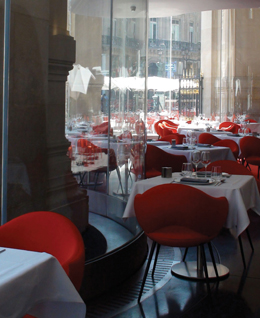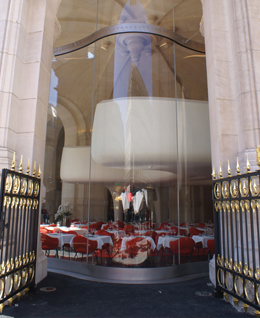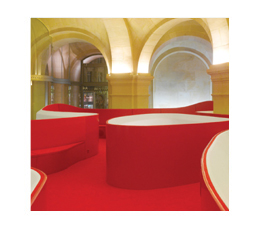Ha llevado más de 150 años en realizarse el diseño original de tener un restaurante en el famoso Palacio Garnier - verdaderamente uno de los edificios más bonitos de París. Por fin, en Junio de 2011 abrió sus puertas el L'Opera Garnier Restaurant, diseño a cargo de Odile Decq, de Odile DECQ Benoit CORNETTE:Architectes Urbanistes, la misma firma que diseñó el apremiado Museo de Arte Contemporáneo de Roma.
Ubicado en el espacio donde antiguamente se estacionaban los carruajes tirados por caballos, el diseño original del edificio lo hizo Charles Garnier en un estilo barroco renacentista en 1875. A lo largo de los años, se le ha llamado L'Opera Garnier, Paris Opera y L'Opera Populaire y la arquitectura fue la pauta de varias operas alrededor del mundo que se construyeron para parecerse a él, siendo también el escenario de la famosa novela gótica de Gastón Leroux "El Fantasma de la Opera" de 1911, y convertido posteriormente en el famoso musical por Andrew Lloyd Webber en 1986.
Detrás de las columnas de la fachada este del edificio, se creó un espacio bajo las más estrictas condiciones ya que no se podía tocar ni las paredes, pilares, ni techo del edificio histórico y debían asegurar la posibilidad de poder retirar el proyecto por completo sin dañar la estructura original.
El resultado es un restaurante oculto tras un velo de vidrio transparente que ondula detrás de las columnas, sujetándose con un marco de metal muy fino apenas visible, permitiendo vistas completas sin un impacto sobre el edificio de una forma casi mágica. Para poder albergar a 90 personas, que fue otro de los requisitos para este proyecto, se construyó un mezzanine continuo multi-nivel, tan dramático como las mejores operas de Puccini, como un navío blanco que se desliza por encima de las cabezas de los comensales, entre columnas creando un efecto como de nube, o hasta de "fantasma", aludiendo al famoso "Fantasma de la Opera". Desde todos los ángulos se aprecia la gran cúpula que ya no parece simétrico, alterando el sentido de la percepción con las diferentes alturas del mezzanine y los tonos rojos profundo de la alfombra y del mobiliario.
La comida corre a cargo de Christophe Aribert, con 2 estrellas Michelin por su restaurante en Grenoble "Les Terrasses" creando platillos tradicionales franceses de productos locales, incluyendo miel y hierbas aromáticas del jardín en el techo de la opera. El estilo es clásico, reinventado con toques personales del Chef. Un bar le da un toque final al restaurante donde se sirven martinis inspirados en temas de opera como Martini Charles y Phantom por Martini.

|
|

It's taken almost 150-years to realize its original design for a restaurant within the famed Palais Garnier – probably one of the most beautiful buildings in Paris. At last, in June 2011 the L'opera Garnier Restaurant finally opened its doors. Designed by Odile Decq , from Odile DECQ Benoit CORNETTE:Architectes Urbanistes, the same firm that design the award winning Museum of Contemporary Art in Rome.
Located in the space that, when the building first opened, horse-drawn carriages would drop-off ticket holders arriving for a performance, the original design by the architect Charles Garnier in Baroque Revival style, was inaugurated in 1875. Over the years, it has been known as Opéra de Paris, L'Opéra Garnier, Paris Opéra and L'Opéra Populaire. Its architecture set a new style for opera buildings, and for the next several decades opera houses around the world were built to resemble it. The building's fame has also been boosted because it is the setting of Gaston Leroux's gothic novel, Phantom of the Opera in 1911 and the popular musical, by Andrew Lloyd Webber (1986).
Creating a new space in the Opera Garnier meant following strict guidelines concerning the historical character of the monument: in order to ensure the possibility of completely removing the project without damage to the existing structure, we were not allowed to touch any of the walls, the pillars, or the ceiling.
The result is a restaurant concealed behind a veil of transparent glass that undulates behind the columns, held by a barely visible metal frame, allowing for complete views without impacting the building in any way. Providing enough floor space to seat 90 people was another requirement for this limited space. The mezzanine was therefore created as a continuous surface, just as dramatic as any of Puccini operas, like a white vessel that slides above the diners heads, in between the columns creating the effect of a cloud or even an allusion to the changing form of the phantom. The symmetry of the cupola is no longer apparent, the reference points change, and sense perception of the space is altered with the multilevel mezzanine and the dark red tones of the carpet and furniture.
At the helm of the restaurant is Christophe Aribert of Grenoble's 2-star Michelin 'Les Terrasses' creating traditional French dishes with local sourced products including an herb and honey garden on the rooftop. The menu is adapted from classic French dishes in true gastronomic style, reinvented around key ingredients sourced personally by the chef from his favorite food purveyors and growers. An additional bar space doesn't disappoint, offering opera theme cocktails like a classic Martini Charles and Phantom by Martini.

|

 L'OPERA by ODBC
L'OPERA by ODBC